5 UGC Metrics to Add to Your eCommerce KPIs

“You can’t improve what you don’t measure.”
This quote, often attributed to Peter Drucker, is one that we hear in the business world quite a bit. And it certainly rings true. Without continuous measurement, it’s impossible for any business to know what’s going well and improve what isn’t.
By now, most brands and retailers that sell online understand the importance of continuous measurement. These brands regularly track myriad key performance indicators (KPIs) to determine how they’re progressing toward their goals – and identify areas to optimize all stages of the funnel.
Some of the most common metrics tracked by brands include traffic, cart abandonment, conversion, sales, and lifetime value – among others. However, the best brands know they must also incorporate certain user-generated content (UGC) metrics into their list of eCommerce KPIs.
In this post, we’ll discuss why UGC metrics matter – and five you should add to your eCommerce KPIs today.
The Importance of Tracking UGC Metrics
It’s a simple fact that modern consumers rely on ratings and reviews, questions and answers, and other types of user-generated content to make informed purchase decisions. Our research found that 74% of consumers consider reviews to be at least somewhat important when making purchase decisions. And 89% read Q&A when deciding whether or not to purchase a product.
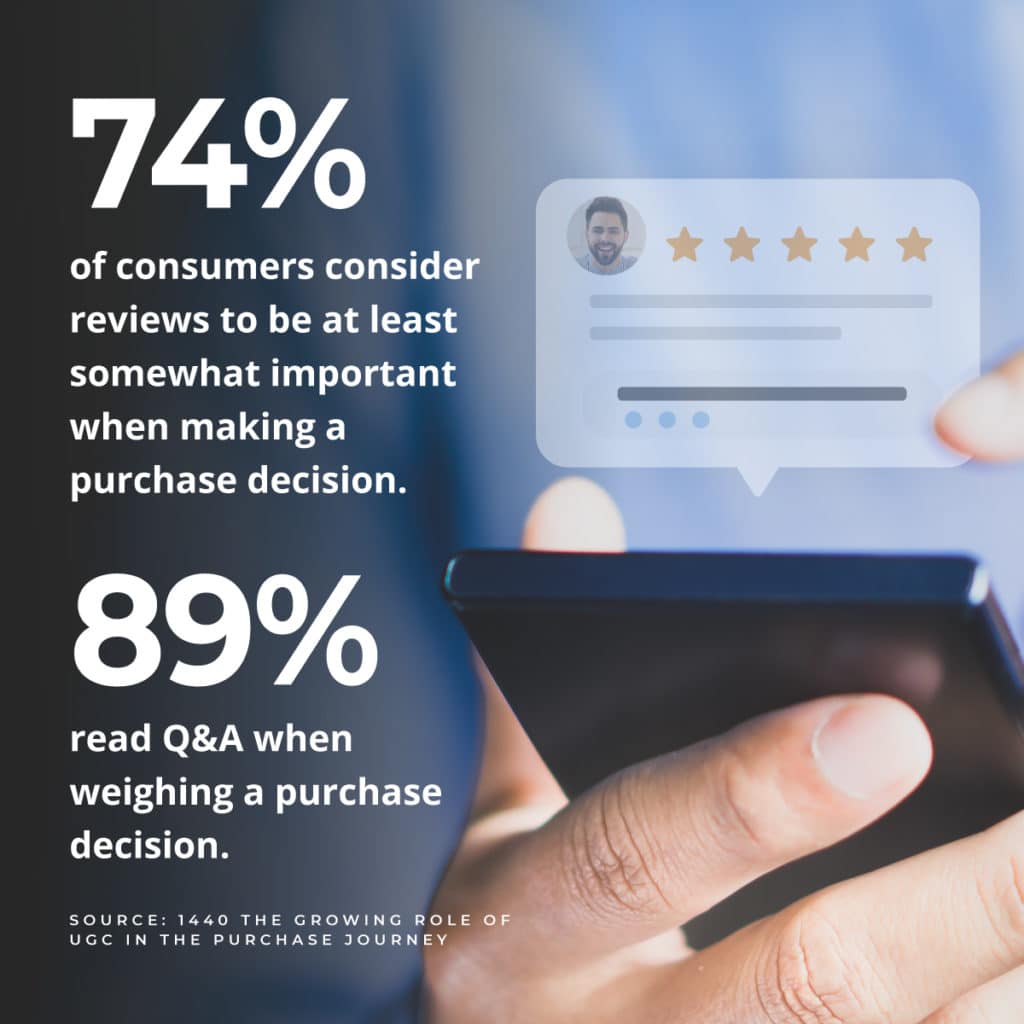
74% of consumers consider reviews to be at least somewhat important when making purchase decisions.
89% read Q&A when weighing a purchase decision.
Source: 1440, The Growing Role of UGC in the Purchase Journey
As the prevalence of online shopping has grown, so too has the importance of UGC. This content helps shoppers better evaluate a product they’re not able to touch and see prior to purchase.
UGC is also a really powerful tool for eCommerce brands. It’s proven to increase traffic. According to our friends at PowerReviews, 81% of all traffic occurs on product pages with reviews.
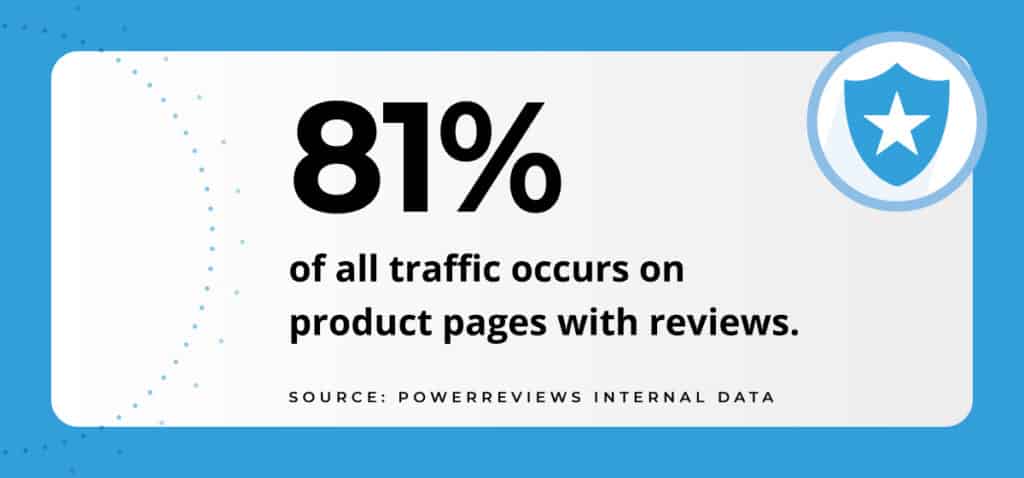
Source: PowerReviews Internal Data
This content also positively impacts conversion. According to Yotpo data, UGC can increase conversion rates by as much as 200%.
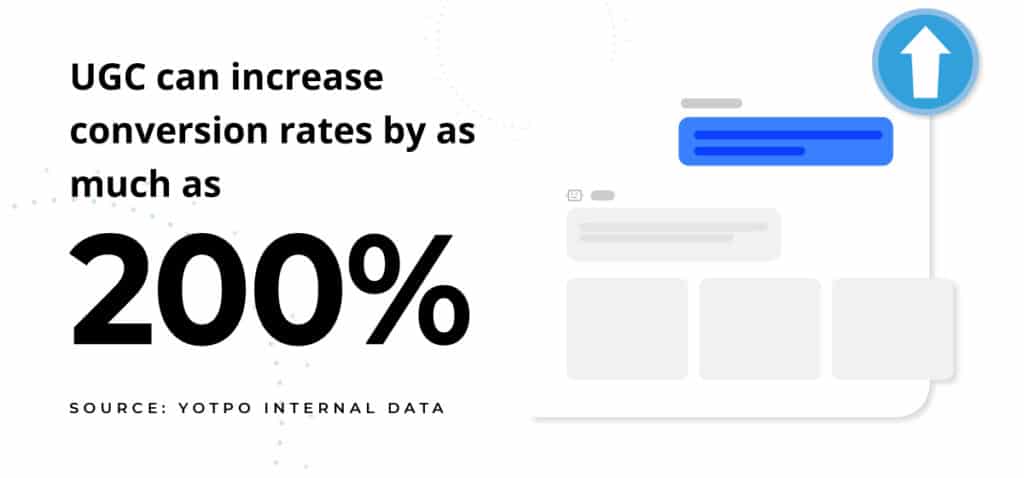
Source: Yotpo Internal Data.
Finally, the insights in reviews and other types of UGC can be leveraged to improve products and experiences – which positively impacts conversion, loyalty, and lifetime value.
Pretty powerful stuff, huh?
Because user-generated content (or the lack thereof) has the power to impact a brand’s bottom line, it’s important for brands to regularly track certain key metrics.
5 UGC Metrics Brands Need to Start Tracking
By regularly measuring key UGC metrics and making changes based on your findings, you can positively impact sales outcomes. But which UGC-related metrics matter the most?
Here are the five UGC metrics tracked by the most successful brands.
#1 Average Star Rating
Depending on the type of review, the average star rating provides a high level overview of how customers feel about a brand, a product, a location, or something else. For example, a four star average star rating for a store location tells us the vast majority of customers like the store – but there may be some opportunities for improvement. On the other hand, an average star rating of one for a piece of furniture suggests that customers have a lot of gripes.
Of course, a great average star rating should be the goal. According to Yotpo, 96% of all products purchased have an average star rating of at least four.
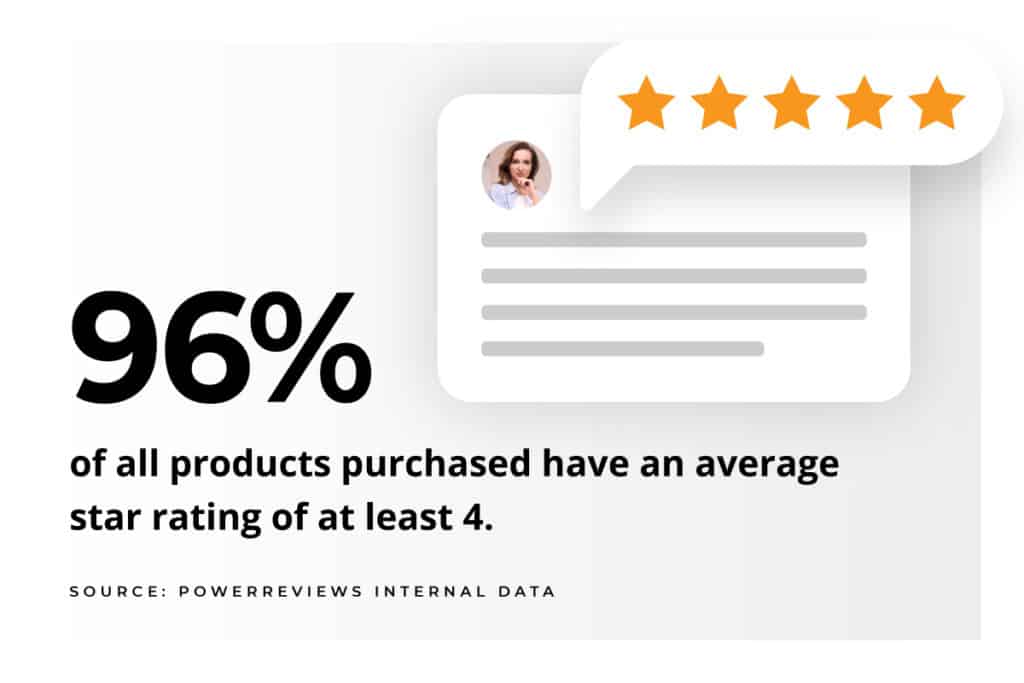
Source: Yotpo, How Star Ratings Influence Customers’ Behavior
But don’t panic if every product doesn’t have a perfect average star rating of 5.0. According to research from Northwestern University, customers perceive perfect average star ratings as too good to be true. Per this research, the ideal average star rating falls between 4.2 and 4.5.
In fact, the occasional negative review can actually be a good thing. It helps future shoppers better determine if a product will meet their needs. And, it’s an opportunity for the brand to respond and restore trust both with the reviewer and future shoppers. Our research found that 73% of consumers would overlook a negative review if there was a sufficient response from the brand.
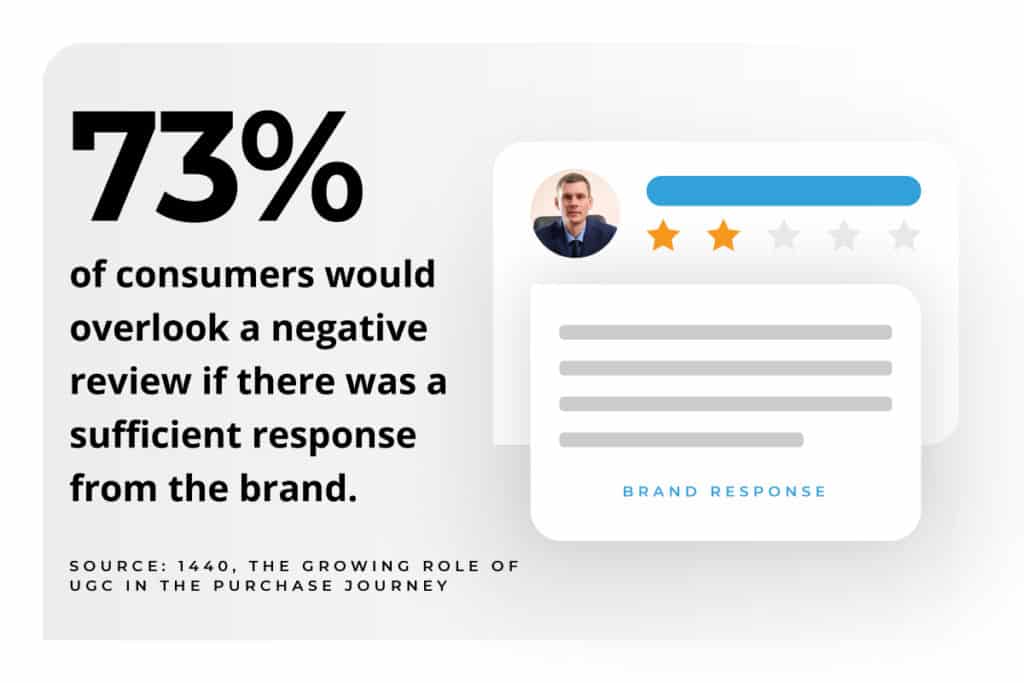
Source: 1440, The Growing Role of UGC in the Purchase Journey
Finally, negative reviews can shed light on opportunities to improve, which can then improve customer satisfaction.
So aim high, but don’t sweat if all of your products don’t have perfect star ratings.
#2 Portion of Products with Reviews
The presence of even a single review can positively impact conversion. Per an analysis from PowerReviews, shoppers who visit a product page with between one and ten reviews are 55.2% more likely to convert than if the page had no reviews.
In order to maximize sales, the goal should be to ensure every product in your catalog has at least one review. Be sure to regularly measure the portion of your products with reviews – and then focus your efforts on generating reviews for those product pages that have none.
#3 Quantity of Reviews
A PowerReviews analysis found that the more reviews, the larger the impact on conversion. While shoppers exposed to 1-10 reviews convert at a rate that’s 52.2% higher than average, products that have 101 or more reviews see a conversion rate increase of over 250%!
As such, it’s important for brands to continuously measure how many reviews they have – both overall and per product. Then, generation efforts can be focused on products with a lower quantity of reviews, which will positively impact conversion.
#4 Q&A and Review Response TIme
When a brand responds quickly to a question posed via Q&A, it helps eliminate the shopper’s uncertainties. That boosts their confidence and likelihood of converting. According to Bazaarvoice, brands that retailers that respond to Q&A see a 98% conversion lift.
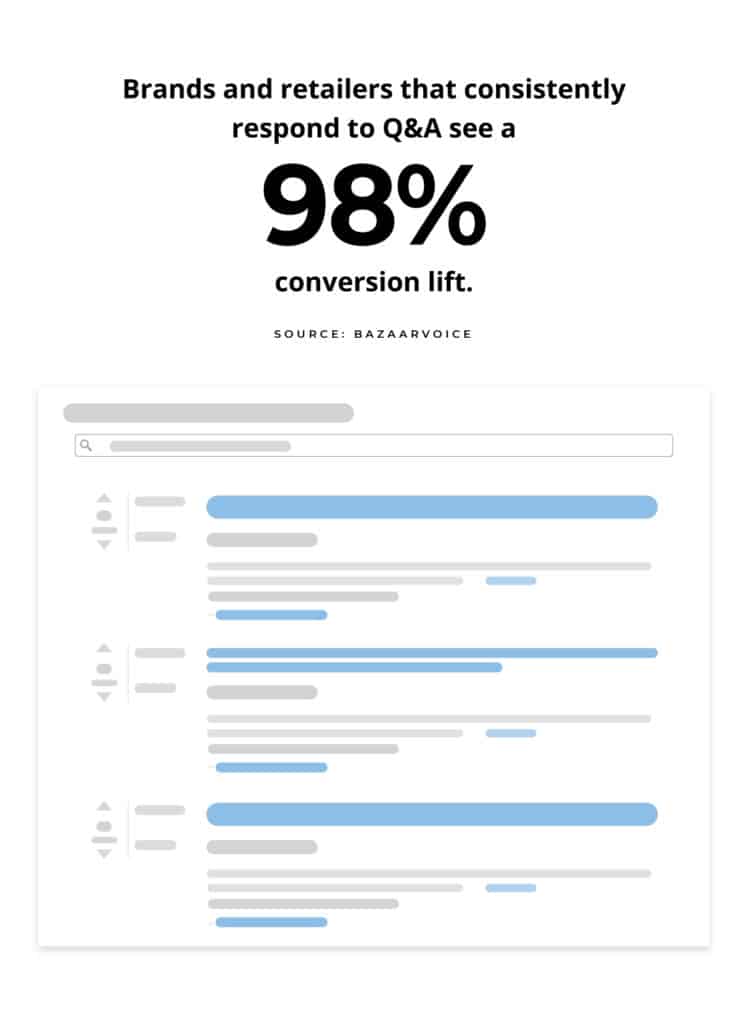
Source: Bazaarvoice
Many shoppers expect responses to reviews, too. Our research found that 81% expect brands to respond to one, two or three star product reviews at least sometimes. And 70% have this expectation for four or five star reviews.
And they’re not willing to wait around. Our research also found that 72% of those who expect a response to a negative review expect it to come within 48 hours. And 70% of those who expect a response to a positive review feel that it should be posted within this same time frame.
By responding quickly, a brand can fix problems, restore trust, foster loyalty and increase lifetime value.
As such, it’s important for brands to track Q&A and review response time, both overall and at the agent level. If your response time is less-than-stellar, consider using a platform like Reputation Studio from 1440, which allows you to consolidate all reviews and Q&A into a single platform: Salesforce. That way, you can more effectively and efficiently monitor content across channels – and provide the timely responses consumers have come to expect.
#5 Actions Taken Based on Reviews and Q&A
Reviews and Q&A are full of powerful insights. Winning brands leverage these insights to deliver even better products and experiences.
What’s more, when shoppers share their feedback via reviews, they expect brands to take action on it. Our research found that over three-quarters (77% of consumers say that if they left a product review with feedback about a problem or flaw, they’d expect the manufacturer to take action to fix it. And 79% expect a manufacturer to fix a product description if they leave a review pointing out inaccurate information.
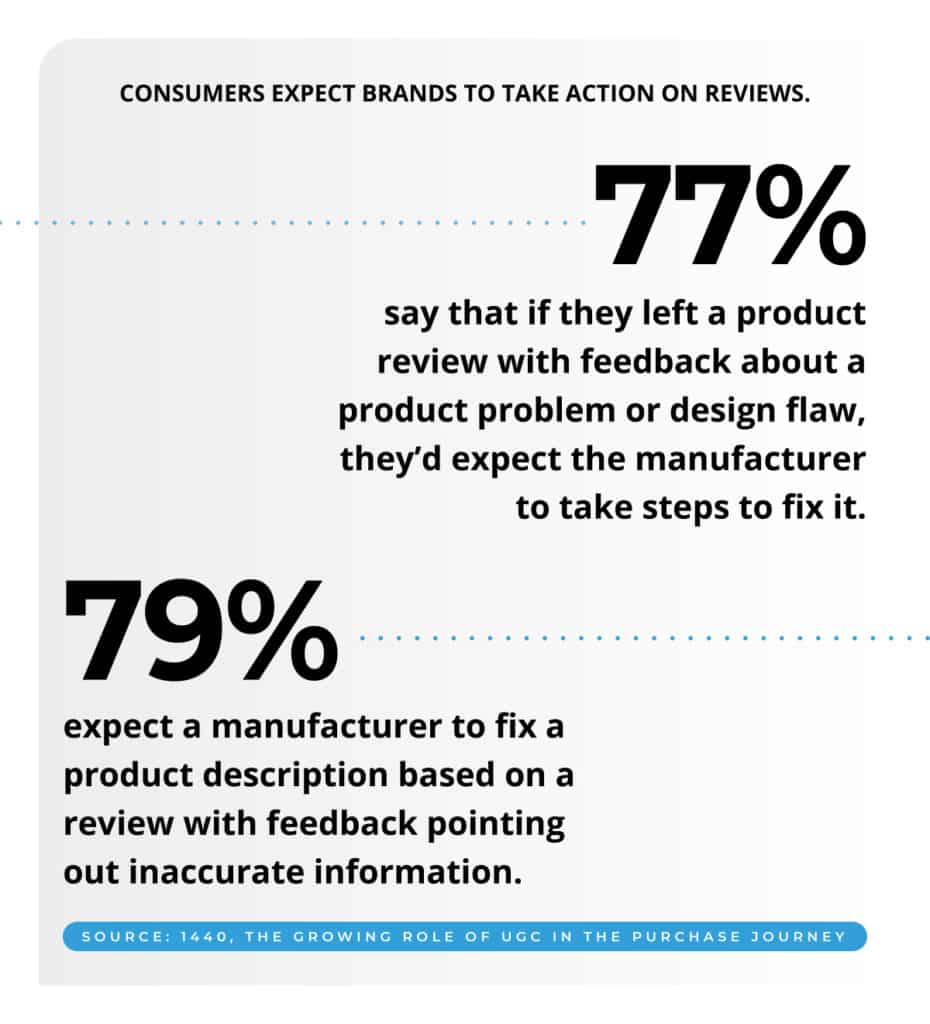
77% say that if they left a product review about a product problem or design flaw, they’d expect the manufacturer to take steps to fix it.
79% expect a manufacturer to fix a product description based on a review with feedback pointing out inaccurate information.
Source: 1440, The Growing Role of UGC in the Purchase Journey
One important metric to track is how often you take action based on customer reviews. Such actions might include fixing a product, updating a product description, or eliminating a product altogether – among others.
Identifying actionable insights in reviews and Q&A can be challenging – especially if you’re collecting many different types of reviews from various sites. However, with Reputation Studio, brands can holistically identify insights and trends across all channels – and then take action on them.
Start Tracking the UGC Metrics That Matter Most
Today, most brands track many metrics to measure success and identify opportunities for improvement. Because UGC is proven to drive conversion, it’s essential to regularly track key UGC metrics. That way, you can optimize your UGC program – and drive even more impact to your bottom line.